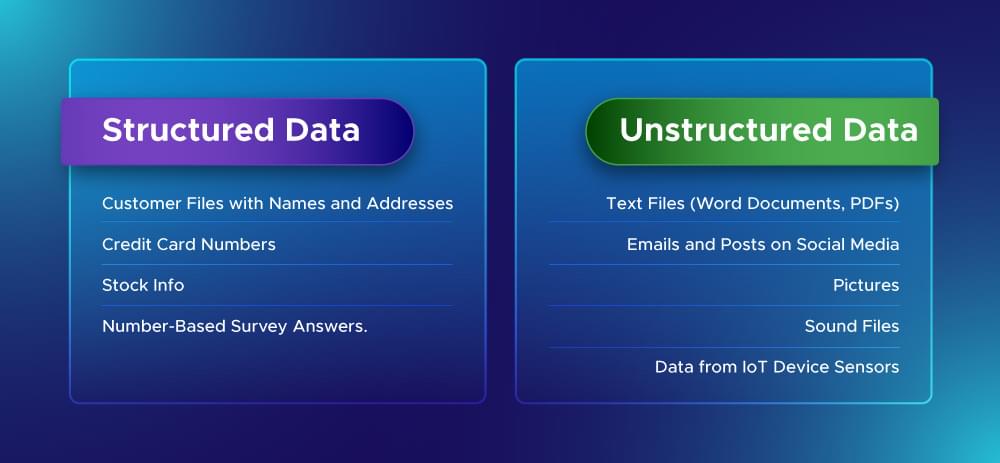Big data has caused a revolution in how companies work and choose what to do. A key part of this change is the difference between unstructured data and structured data. As you deal with the complex world of data analytics and business intelligence, it’s essential to understand these two types of data to use them in your company.
Web scraping operations frequently encounter both data types—from structured product catalogs and pricing tables to unstructured customer reviews and social media content. Crawlbase solutions are designed to handle both structured and unstructured web data seamlessly, automatically adapting extraction methods based on the content type encountered.
This article looks into the main features that make unstructured data different from structured data. You’ll learn about their definitions and forms, see the problems and chances in storing and managing data, and find out how each type has an impact on analyzing and processing data. By the time the end of this article, you’ll see how these data types shape the world of machine learning web scraping and enable you to make better business choices.
What is Structured Data?
Structured data means info that follows a set layout and order. It fits a specific data model so both people and machines can read and grasp it. You’ll typically see structured data in relational databases or spreadsheets set up in rows and columns with fixed fields.
The main features of structured data are:
- Clear structure with identifiable traits
- Same order and format throughout
- People and computer programs can access and use it
- Stored in preset schemas like databases
Some structured data examples are customer files with names and addresses, credit card numbers, stock info, and number-based survey answers.

What is Unstructured Data?
Unstructured data doesn’t follow a set data model or pattern. This kind of information takes many shapes and can’t fit into regular databases. Unstructured data is more about quality and needs special methods to analyze it well.
Unstructured data examples:
- Text files (Word documents, PDFs)
- Emails and posts on social media
- Pictures, sound files, and videos
- Data from IoT device sensors
Structured vs Unstructured Data
To get a good grasp on how structured and unstructured data formats differ, let’s look at their main features:
- Storage: People usually keep structured data in relational databases (RDBMS) that use SQL. On the other hand, unstructured data finds its home in non-relational (NoSQL) databases or data lakes.
- Organization: You’ll find structured data arranged in tables with rows and columns. In contrast unstructured data doesn’t have a set structure and stays in its original form.
- Querying: SQL makes it a breeze to search and work with structured data. However, when it comes to unstructured data, you need special tools and methods to analyze it.
- Flexibility: Structured data has limitations when it comes to adding new types of information, as schema changes need significant database updates. Unstructured data gives you more room to work within this area.
- Processing: Machine learning systems can handle structured data with ease, but unstructured data often calls for more advanced methods to get meaningful insights.
Storage and Management
Structured and unstructured data extraction pose different challenges and offer various opportunities when it comes to data management and storage. Let’s take a closer look at how organizations store and manage these two types of data in various settings.
Structured Data Storage
Relational databases and data warehouses store structured data. These systems use a predefined schema, often called “schema-on-write,” which means you decide on the data structure before storing it. You’ll find that Structured Query Language (SQL) manages structured data, making it easy to input, search, and change data.
Data warehouses, with their strict schemas, work well to store structured data. But this strictness can cause problems when it needs to change. Any changes to the schema might force you to update all the existing structured data, which can take a long time and disrupt your work.
Unstructured Data Storage
Unstructured data lacks a predefined data model. Users store this data in its original format and process it when necessary, a method called “schema-on-read.” To handle the huge amounts of unstructured data, which can make up to 90% of company data, you’ll need more adaptable storage options.
Cloud data lakes have gained popularity to store unstructured data. They provide enormous storage abilities with pricing based on usage, making them cost-effective and easy to scale. NoSQL databases offer another choice, allowing you to store different data formats without a fixed structure.
Management Challenges
Unstructured data management poses several hurdles. The massive amount of diverse types and rapid influx of unstructured data can overwhelm traditional storage systems. As your data expands, you’ll need a storage infrastructure that manages data efficiently.
To analyze unstructured data, you need special tools and methods, like natural language processing, machine learning, and AI. These advanced technologies can help you gain valuable insights from various data types, such as text documents, images, and videos.
To tackle these issues, think about putting a data management plan into action that includes:
- Adaptable data models to handle new fields and data types
- Strong storage systems supporting quick responses and speedy data updates
- Data archiving that works well to stop data loss and cut storage costs
- Solutions that can scale up as your data needs grow
Data Analysis and Processing
Looking at and working with data is different for organized and messy information. Knowing these differences is key to getting useful insights from your data.
Structured Data Analysis
Structured data analysis deals with information that follows a set format often found in tables or databases. This data type has a clear organization and people can search it using standard methods. The consistent and reliable nature of structured data adds to the quality and trustworthiness of the analysis process.
You can use structured data to:
- Carry out precise and quick analysis
- Use advanced analytical methods like statistical models and machine learning
- Build reports, dashboards, and visuals to gain useful insights
- Search, filter, and sort data with ease for focused exploration
Unstructured Data Analysis
Unstructured data analysis aims to make sense of information that doesn’t fit into typical rows and columns. This includes text, images, videos, and more. The process involves looking at, cleaning up, changing, and modeling data using different analytical and statistical tools.
Key aspects of unstructured data analysis include:
- Natural Language Processing (NLP) to analyze text
- Techniques to analyze images and videos
- Methods to process audio
- Analysis of sensor data from IoT devices
Processing Techniques
To handle both structured and unstructured data well, you need to use different processing methods:
- Data Classification: Group data by metadata, like file type or content, to boost management and follow rules better.
- Metadata Analysis: Use “data about data” to gain insights for unstructured stuff like blog posts or pictures.
- Machine Learning: Use AI systems to study and find meaning in unstructured data, like spotting things in images or sorting text.
- Data Visualization: Show data in pictures or graphs so people can understand and study it more.
Leverage Both Data Types for Comprehensive Insights
As data keeps getting more extensive and more diverse, companies need to come up with plans to handle both structured and unstructured data well. This means putting money into storage solutions that can grow, using cutting-edge analytics methods, and applying machine learning to get insights from different data sources.
For businesses collecting web data, this dual approach becomes even more critical. Crawlbase’s suite of tools excels at extracting both structured data (like product specifications, prices, and inventory levels) and unstructured content (such as reviews, descriptions, and social media posts) from any website. Our intelligent parsing algorithms automatically identify and organize different data types, delivering clean, analysis-ready datasets regardless of the source format. Sign up today.
FAQs
What is structured vs. unstructured data?
Structured data has an organization that allows it to fit into tables or databases. It includes specific types such as numbers, short texts, or dates. Unstructured data, however, has a challenging organization due to its nature or size. This type includes formats like audio, video, and large text documents.
Can you list five key differences between structured and unstructured data?
Sure, here are the main differences: Structured data has standardization and searchability, while unstructured data often stays in its original form. Structured data is quantitative, so you can measure and count it, but unstructured data is qualitative, focusing more on descriptions. Also, structured data lives in data warehouses, while unstructured data ends up in data lakes.
What best describes unstructured data?
One standout thing about unstructured data is that it doesn’t follow a specific data model. This sets it apart from structured data, which sticks to a clear model and organization.
What are the characteristics of structured data?
Structured data sticks to a data model with a clear structure that puts info into rows and columns. This setup makes sure that the data’s definition, format, and meaning are well-defined and stay that way.










